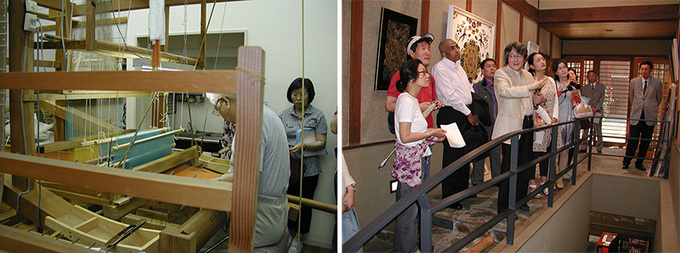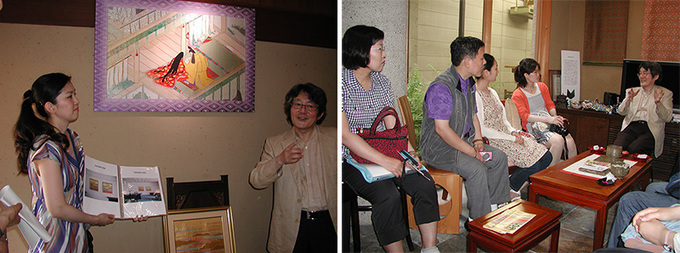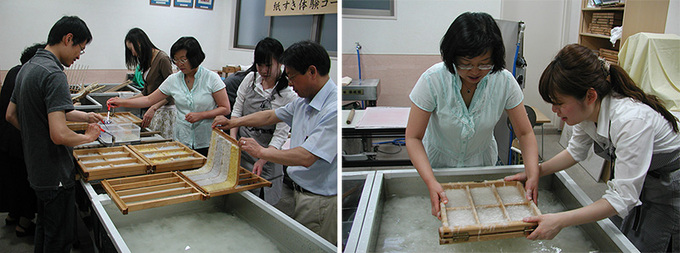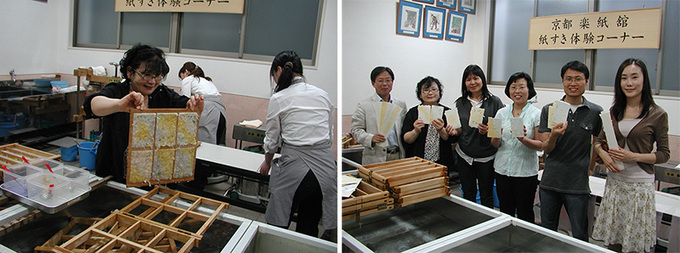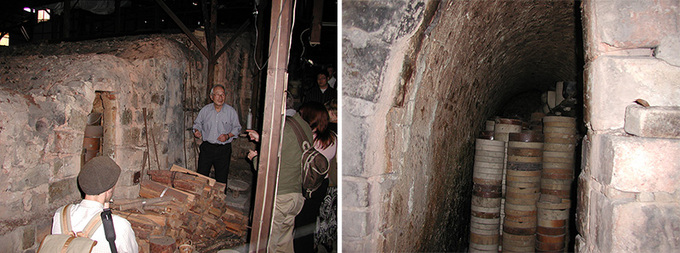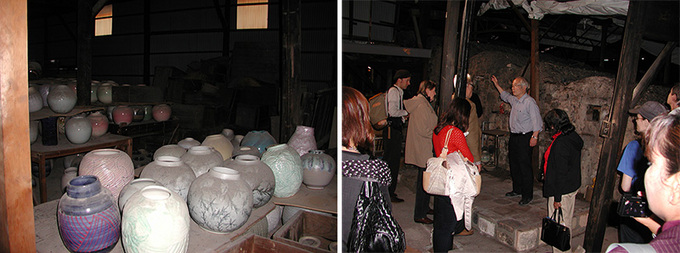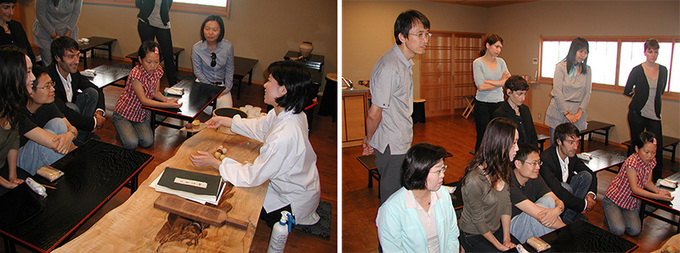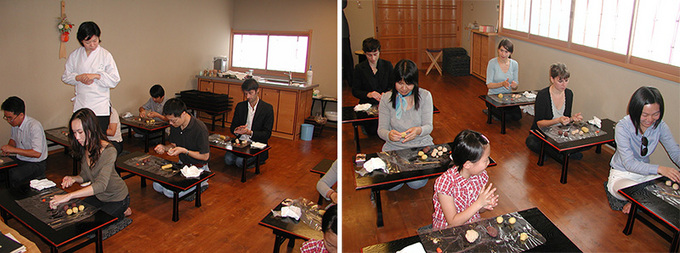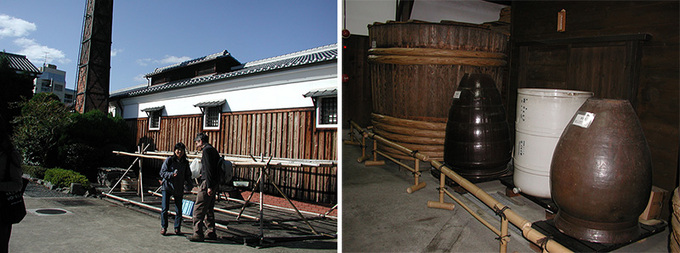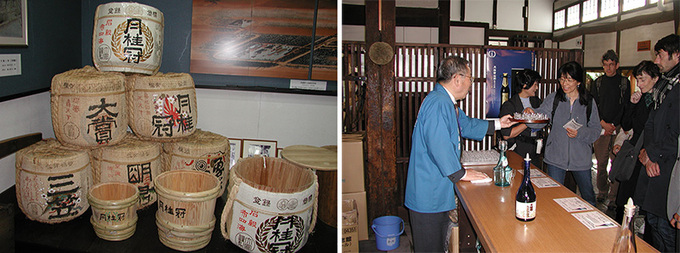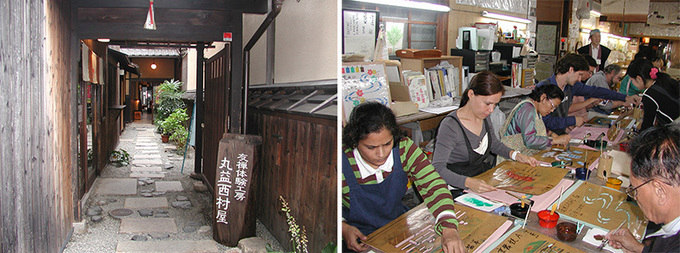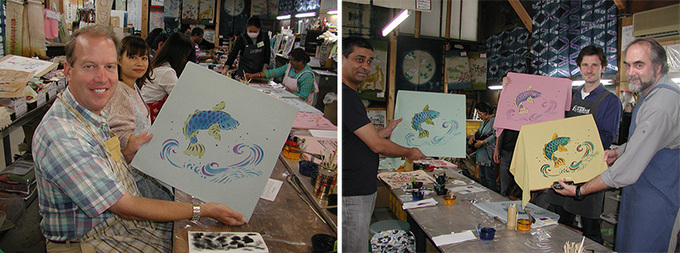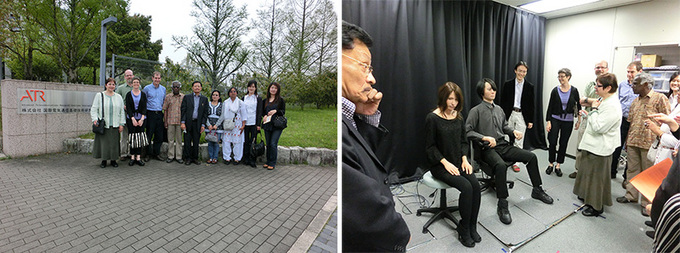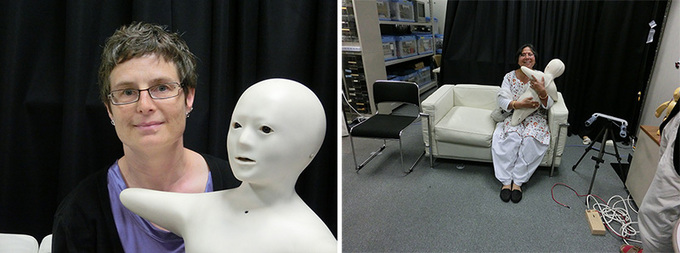The Cultural Experience Program--Promoting Japanese Culture from Kyoto
Nobutaka Saiki
The Japan Foundation Kyoto Office
The Japan Foundation Kyoto Office promotes understanding of Japan by presenting various events and activities which mainly target foreign students and researchers living in Japan, often in collaboration with other international cultural exchange organizations in the Kansai region. It also provides opportunities for dialogues and communication between the foreign visitors and local citizens with an interest in intercultural experience. This article highlights some of the programs organized by the Kyoto Office.
Noh and Kyogen in the eyes of foreigners
The Kyoto Office's annual autumn program entitled "An Evening of Noh and Kyogen" is designed to provide an opportunity for foreigners living in the Kansai region to enjoy and experience Japanese traditional theater. In 2012, the program was staged on November 20 as part of the commemorative project of the 40th anniversary of the Japan Foundation and the 15th anniversary of the Japanese-Language Institute, Kansai.
The program consisted of two plays. The first was a Kyogen piece entitled Ne Ongyoku (Horizontal Singing) featuring Sengoro Shigeyama, and the second, a Noh piece, was Ikkaku Sennin (The Horned Hermit) featuring Kurouemon Katayama. Held on a chilly evening in late autumn, the performance nevertheless attracted a huge crowd of people who queued up outside the Kyoto Kanze Kaikan Hall well before the doors opened. This event was a great success, with the plays performed to a full house of spectators from diverse backgrounds, including international invitees to the Japan Foundation programs, foreign students, diplomats and artists.

Photos (Left bottom and right bottom): Akio Takahashi
To find out what the audience thought of the Noh and Kyogen, the Kyoto Office ran a survey and had its staff speak with some of the guests at the end of the program. Here are some of the comments we received:
This was my first Noh experience. I expected it would be similar to an opera, but the two are completely different. In the opera, the orchestra is kept hidden whereas in the Noh performance, the jiutai (the chorus) and hayashikata (the instrumentalists) appear on stage and as a part of the composition, play an important role with the actors.
(Student from Italy)
Compared to the way actors move in European classical theater, the Noh performance was like watching a slow motion picture. But each of the deliberate and carefully controlled hand movements or gestures was exquisitely in sync with the sounds of the drums and the chorus.
(Artist from Germany)
Although Noh was developed in Japan, I felt a strong connection to it because some of the plays are set in China and other parts of Asia.
(Student from China)
Presenting the formality and solemnity of Noh with the comedy of Kyogen in a single program is a distinctly Japanese practice not found in Europe.
(Diplomat from Italy)
Kyogen is funny and easy to understand. In some respects it resembles the Italian comic theater.
(Researcher from Italy)
I was amazed by the sheer beauty of the Noh costumes. It was astonishing how the actors so successfully expressed their inner thoughts and emotions even though their faces were covered in a motionless mask. The performance gave me a glimpse into the deep roots of this 600-year-old traditional art.
(Student from the U.S.)
These comments go far beyond simple excitement at having discovered something new. They demonstrate that the respondents tried to grasp the essence of Japanese culture while comparing it to their own. Their keen and insightful observations are nothing short of remarkable.
Experiencing Japanese culture--From traditional crafts to cutting-edge technology
"An Evening of Noh and Kyogen" has been a hugely successful program for introducing Japanese culture to foreign students and researchers, but the city of Kyoto has much more to offer than the traditional theater. To provide wider and more varied opportunities to discover and get a taste of Kyoto and its culture, the Kyoto Office launched its Japanese Culture Experience Program two years ago.
A visit to a nishikiori weaving studio
A group of participants visited the studio of Koho Tatsumura, a recognized expert in nishikiori, a traditional weaving technique. Following a lecture on the history of Japanese textiles and on Tatsumura's work, they were able to watch the art of weaving. The participants looked quite impressed with the beautiful fabrics and even more thrilled to learn about the different stages of the weaving process.
Washi paper-making class
The participants took part in a washi paper-making class offered by RAKUSHIKAN, an established washi paper and paper products company.
Comments:
"I've seen washi before, but only as a finished product. I wanted to learn how it is made and was excited to get a chance to participate in the paper-making process."
"Now I know much more about washi."
Kiyomizu-yaki pottery studio visit
On a visit to the studio of Fujihira Pottery, located in Higashiyama Gojo in Kyoto, the participants had the chance to observe the climbing kiln and learn about ceramics. One person said he gained an understanding about the historical background of Kyoto's traditional ceramics, and another commented that she had increased her knowledge of the pottery making process.
Wagashi making experience
At one of the long-standing wagashi shops in Kyoto, Oimatsu, the participants had a go at making the traditional Japanese sweets. The wagashi making session, which followed a lecture on the history of wagashi, proved a delightful experience for everyone who took part.
Comments:
"Wagashi is not just about the taste; the sweets incorporate a sense of the seasons."
"The hands-on experience teaches you much more than just looking at a demonstration."
A sake brewery tour
The tour of Gekkeikan's sake brewery located in Fushimi, Kyoto, consisted of a guided tour of the brewery equipment and the production lines, followed by a tasting session. Sake is popular overseas, said one participant, but this was the first time he actually saw how it was made. He described the tour as a great cultural experience, teaching him the difference between the production process of wine and that of sake.
Yuzen dyeing workshop
A group of participants visited the studio of Marumasu-Nishimuraya to learn the Kyo-Yuzen dyeing technique. After dyeing a furoshiki wrapping cloth, a participant said she found the activity rewarding and fun. Another commented it was a valuable experience that provided an opportunity to appreciate the aesthetics encapsulated in the Yuzen dyeing method.
The robotics research laboratory tour
This program took place at the Advanced Telecommunications Research Institute International (ATR) located in Kansai Science City (also called Keihanna Science City). The participants first heard a lecture on the latest robotics research, then were invited to touch the newly developed robots on exhibit. Everyone was excited to see the robots; some marveled at the advanced level of Japanese robotics research and one person said "I realized that there is a link between traditional craft and cutting-edge technology."
The Japanese Culture Experience Program's achievements and discoveries
The Japanese Culture Experience Program was attended by a diverse mix of foreign nationals, including researchers from around the world invited to Japan under the Japan Foundation's fellowship program and artists visiting the country through various academic and cultural programs sponsored by organizations such as the Goethe-Institut and the Maison Franco-Japonaise.
The Kyoto Office is pleased that it was able to provide a fruitful opportunity for the participants--who are individuals with extensive knowledge in their respective fields of expertise, but not specialists in every area of Japanese culture--to get a first-hand, personal experience of Japanese culture.
Covering a range of topics from traditional crafts to the latest technology, the program took the participants to the sites of production where they all expressed delight at having had the chance to not only see the finished products but also observe or participate in the process that leads to the creation of the objects.
The workshop classes were at times a struggle for first-timers according to some participants, but actually taking part in the Japanese sweets and paper making and Yuzen dyeing activities helped develop a surface knowledge of these aspects of Japanese culture into a deeper understanding and appreciation.
They also said they were struck by the professional spirit of the craftsmen who form the backbone of the manufacturing trades. Talking to the artisans in a range of fields from traditional arts, such as weaving and dyeing, to food, such as sake and sweets, the visitors said they encountered, and were deeply inspired by, the passion for the work, the commitment to perfection almost to the point of being stubborn, and the willingness to innovate while sustaining the tradition. This was the moment when they went from having a budding interest in Japanese culture, to being actually touched by it, thanks to the activities that offered close contact with the traditional arts and practices.
The thoughts and comments on the program offered by the participants, who have cultural backgrounds different from ours, introduce us to a whole new aspect of our own culture that we hardly noticed before.
Kyoto is a rich cultural treasure trove ideally positioned to showcase and promote Japanese culture to the rest of the world. Taking full advantage of the city's assets and resources, the Kyoto Office will strive to offer quality programs for our foreign friends that provide an insight into the deep roots of Japanese culture. It would certainly be a pleasure if, in the process, our fellow Japanese get to re-discover new facets of our own culture.
The Japan Foundation Kyoto Office
3rd Floor, Kyoto International Community House
2-1 Torii-cho, Awataguchi,
Sakyo-ku, Kyoto, 606-8436 JAPAN
(6-minute walk from Keage Station of Tozai Subway Line)
TEL: +81-(0)75-762-1136
Keywords
- Fashion
- Traditional Arts
- Handicraft
- Theater
- Culture and Society
- Performing Arts
- Music
- Food Culture
- Science Technology
- Japanese Studies
- Japan
- Kyoto
- Kansai
- Kyoto Office
- Noh
- Kyogen
- Japanese-Language Institute
- Kansai
- Sengoro Shigeyama
- Kurouemon Katayama
- Kyoto Kanze Kaikan
- Opera
- Orchestra
- Nishikiori
- Koho Tatsumura
- Paper-making
- RAKUSHIKAN
- Washi
- Kiyomizu-yaki
- Higashiyama Gojo
- Fujihira Pottery
- Wagashi
- Oimatsu
- Fushimi
- Gekkeikan
- Sake brewery
- Sake
- Wine
- Yuzen dyeing
- Marumasu-Nishimuraya
- Furoshiki
- Robot
- Kansai Science City
- Keihanna Science City
- Advanced Telecommunications Research Institute International
- ATR
- Goethe-Institut
- Maison Franco-Japonaise
Back Issues
- 2023.4.10 The 49th Japan Found…
- 2023.3.28 JF's Initiatives for…
- 2023.1.27 Living Together with…
- 2022.11.16 Inner Diversity <…
- 2022.6.21 The 48th Japan Found…
- 2022.3.22 JF's Initiatives for…
- 2022.3.14 JF's Initiatives for…
- 2022.2.14 JF's Initiatives for…
- 2022.2. 4 JF's Initiatives for…
- 2021.12.13 JF's Initiatives for…



